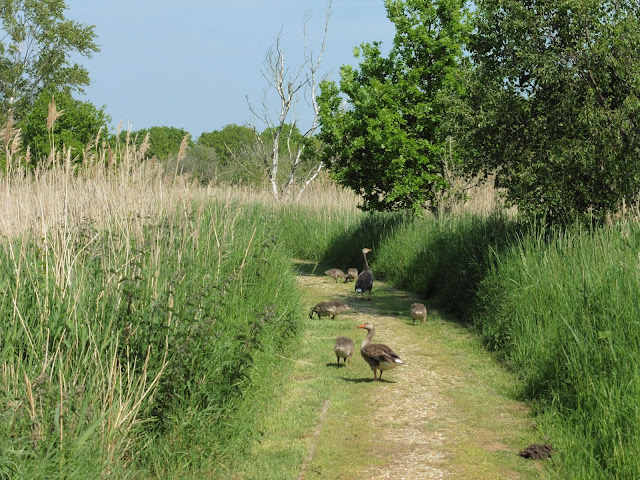Planning
Honeyguide days out with an eye on the weather forecast doesn’t always work out
but today it did, with Goldilocks weather – not too hot, not too cool. It was ideal
for a mixture of a morning on the beach at West Runton and an afternoon at
nearby Beeston Common. We assembled at West Runton’s clifftop car park where we
could hear or see a skylark, whitethroat and linnets, plus a steady movement of
sand martins, many of which we later saw around their nest holes in the cliffs.
A coach with a large party of school age children also arrived, though the
beach was far from crowded early on a week day.
Rob
Lucking gave a splendid summary of the mix of chalk and flints that we were
looking at on the exposed foreshore as the tide retreated, so good that I persuaded
him to write it down.
 |
| Paramoudra magna with some of the Honeyguide group. |
‘The chalk reef that runs between Sheringham & Cromer was laid down between 60 million and 100 million years ago when the planet was much warmer than it is now and covered with shallow tropical oceans. The chalk is formed from the skeletal remains of tiny marine organisms that settled on the ocean floor and was compressed to form the chalk rock we see today. Chalk was formed very slowly – as a rule of thumb, 1cm depth of chalk would take 1000 years to form.
‘Flints are commonly found in the chalk layer and while no-one knows exactly how flints were formed, one theory is that as the tiny marine organisms that formed the chalk decomposed in anaerobic (without oxygen) conditions hydrogens sulphide gas was formed. This combined with oxygen higher up in the water column and formed sulphuric acid which slowly dissolved silicates from the skeletons of marine organisms and eventually formed a highly concentrated solution of silica that solidified in gaps in the chalk forming the irregular flint nodules found on the beach at West Runton.
‘An interesting feature of West Runton beach is the large number of ‘paramoudra’ or pot stones and flint rings which are thought to be the fossilised remains of marine sponges. The flint rings are thought to be the remains of barrel sponges where the organic wall of the sponge has been replaced with flint (or silicified) and the hollow centre filled with chalk. The pot stones are flint nodules with hollow centres, sometimes looking like giant vertebrae.’
 |
| Paramoudra typica. |
Where the wet sand joined the shingle beach was the first Paramoudra magna, a ring about two metres across. There were many more, and examples of Paramoudra typica, a stone ring with or without a chalk core, and more complex mixtures of bigger rings and inner Paramoudra.
We continued to find belemnites as we pottered in the rock pools. There were thousands of winkles and dog whelk shells in various colours. Doug found a hermit crab in a winkle shell and we think a tiny fish was a common goby. There were limpets and barnacles, of course, a sea slater (like a marine woodlouse), and the occasional crab and shrimp.
 |
| Dog whelks. |
 |
| Belemnites, with winkles. |
Beadlet anemones were what I photographed more than anything else, some under water with tentacles out, others out of the water and closed, though I failed to find (or photograph today) the blue stinging ‘beads’ under the tentacles that give them their name.
 |
| Beadlet anemone. |
It wasn’t a day for many birds on the shore: lots of herring gulls, mostly immatures, and a cormorant, though we did see a fulmar fly along the cliff and sand martins around their holes. We walked across to the cliff and admired sheets of kidney vetch, bladder campion and bright yellow stonecrop, and smelt the strongly scented leaves of sea wormwood. We ate our picnics in the sunshine in the car park, or bought something from the Seaview Beach Café.
 |
| Kidney vetch. |
 |
| Sea wormwood. |
 |
| Common spotted orchid, Beeston Common. |
Ann was watching a dragonfly egg-laying in a well-vegetated watercourse, and it settled by the path. It was a keeled skimmer, and we couldn’t have hoped for a better view of her shoulder stripes and the bold line on the abdomen that gives the ‘keel’ in the name. My experience with keeled skimmers is that sometimes they allow a close approach for a photo, and so it proved.
 |
| Keeled skimmer, female. |
We followed the path where the keeled skimmer had settled, taking us around a lush buttercup meadow and to a large pond. Here a female broad-bodied chaser was egg-laying, a four-spotted chaser perched, and an emperor dragonfly patrolled.
 |
| Meadow thistle. |
A little farther into the common we explored more damp meadows, where the best flowers were all conveniently near the cut path. We’d seen lots of marsh thistle; now there was a lovely (and spine-less) meadow thistle. Sphagnum moss had great patches of red sundew leaves. While much of this was round-leaved sundew we also found great sundew Drosera anglica. There were many of the distinctive rosettes of butterwort, one of which had a flower.
 |
| Round-leaved (common) sundews. |
 |
| Great sundew Drosera anglica. |
 |
| Butterwort. |
We walked around some more of the more wooded and heathy areas of the SSSI, concluding that some birches were downy birches, before walking back to the lay-by and buying an ice cream.
Chris Durdin












